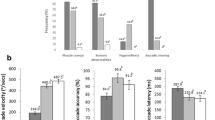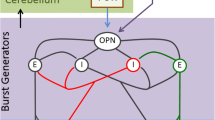Abstract
Recent studies have shown that the severity of the several clinical symptoms of myotonic dystrophy (DM) is closely related to the size of a CTG triplet repeat in the gene encoding myotonin protein kinase. Although neurotological findings, including saccadic slowing in patients with DM, have been reported, the relationship between these neurotological findings and elongation of the CTG triplet repeat has not been discussed to our knowledge. We made a case-control study that compared the saccadic velocity in 13 patients with DM and in 13 controls matched for age and sex. We also examined the correlation between the saccadic velocity in DM patients and the size of the expanded DNA fragment (EF) obtained by Southern blot analysis with EcoRI or BglI.
We found: (1) The primary eye position was normal in 9 of 12 patients. Divergent strabismus was present in 3 patients. (2) The range of ocular movement was normal in 2 patients, nearly normal in 5 and minimally limited in the other 5. (3) Only 1 patient had lateral gaze nystagmus, which was fine and transient. (4) The horizontal saccades were essentially normometric in 11 of the 13 patients, slightly hypometric in 1 and obviously hypometric in 1. These last 2 patients had the second longest and longest EF sizes. The vertical saccades were essentially normometric in 8 of 12 patients, hypermetric in 3, and hypometric in the 1 with the longest EF size. (5) The saccadic velocity in the DM patients was significantly lower than that in the controls in the horizontal or vertical direction, the difference being more prominent in the horizontal direction. (6) The correlation coefficients between horizontal saccadic velocity and EF size, 0.801 (EcoRI) and 0.756 (BglI), had a strong negative correlation (P < 0.01 for both EcoRI and BglI). No statistically significant correlation was found between vertical saccadic velocity (upward and downward) and EF sizes.
Although it was difficult to determine whether saccadic slowing was caused by central oculomotor system involvement or extraocular muscle atrophy, the absence of gaze-evoked nystagmus in almost all of the patients favours the latter.
Our study shows that neurotological examinations that include a saccadic velocity test are very useful for detecting subtle eye movement abnormalities in DM and for quantitatively evaluating the clinical severity of DM.
Similar content being viewed by others
Author information
Authors and Affiliations
Additional information
Received: 7 October 1997 Received in revised form: 10 February 1998 Accepted: 20 March 1998
Rights and permissions
About this article
Cite this article
Osanai, R., Kinoshita, M. & Hirose, K. Saccadic slowing in myotonic dystrophy and CTG repeat expansion. J Neurol 245, 674–680 (1998). https://doi.org/10.1007/s004150050266
Issue Date:
DOI: https://doi.org/10.1007/s004150050266




